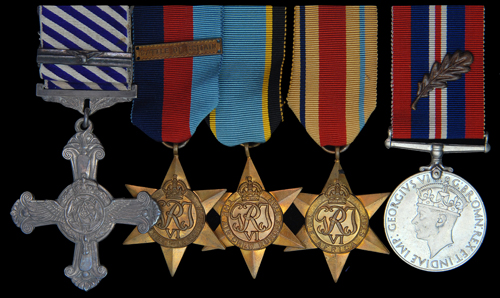
Auction: 8016 - Orders, Decorations, Medals & Militaria
Lot: 285
The [D.S.O.], D.F.C. and Bar Group of Five to Battle of Britain, 601 Squadron, Hurricane Fighter Ace, Wing Commander H.C. Mayers, Royal Air Force, Who Was Credited with 8 Victories in the Battle, Together with 4 Probables and 2 Damaged All Within British Air Space, He Later Increased His Score to Over 11; He Was Shot Down 4 Times Including Twice During the Battle; His Luck Ran Out on the Last Occasion in July 1942 When He Force Landed His Kittyhawk in the Western Desert; He Was Captured and Then Reported Missing When a Ship with British Prisoners, Enroute to Sicily, Was Sunk in the Mediterranean - He Was Never Seen Again a) Distinguished Flying Cross, G.VI.R., reverse dated ´1940´, with Second Award Bar, reverse dated ´1942´, this loose as issued, in Royal Mint case of issue b) 1939-1945 Star, with Battle of Britain clasp, this loose as issued c) Air Crew Europe Star d) Africa Star e) War Medal, M.I.D. Oakleaf, this loose as issued, generally extremely fine, with the following related contemporary items: - Two single D.F.C. riband bars, one with rosette denoting Second Award Bar - Two double riband bars for D.S.O. and D.F.C. awards, last with rosette denoting Second Award Bar for D.F.C. - Bestowal Document for the Distinguished Service Order, dated 28.7.1942 - Named Condolence Slip - R.A.F. Pilot´s Flying Log Book (4.1.1940-8.7.1942), well annotated and replete with newspaper cuttings and photographs of recipient and his contemporaries, including some of the ´characters´ of 601 Squadron, such as Willie Rhodes Moorhouse (son of the first airman to win the V.C.); G.N.S. ´Mouse´ Cleaver; Sir Archibald Hope; Humphry ´Hot Pants´ Gilbert; H.F. ´Peggy´ O´Neill; and Whitney Straight (lot) Estimate £ 18,000-22,000 D.S.O. London Gazette 28.7.1942 Acting Wing Commander Howard Clive Mayers, D.F.C. (77976), Royal Air Force Volunteer Reserve. The Recommendation states: ´´W/Cdr. Mayers took over No. 239 Wing on 23.4.1942 1 squadron from this wing was the first to be fitted with Kittyhawk Bombers and another squadron was the first to be fitted with long range tanks. His tactical knowledge and personal interest in every operation has been a big factor in the success of the Kittyhawk Bomber and of the Long Range Kittyhawk Fighter, and his enthusiasm for both types overcame any reluctance on the squadron to be diverged from their normal role of air fighting. No. 6 Squadron with their Hurricane 11D´´s were posted to this Wing and it was due entirely again to his tactical knowledge that No. 6 Squadron were able to have such success. In all cases he has led the first few operations where new tactics were employed. On the 8/5 and the 12/5 he led both long range interceptions of supply aircraft on the Derna-Crete route, resulting in the interception of a large enemy force in which 13 (or 23 corrupt) JU 52´´s were destroyed. On this sortie he personally destroyed 1 JU 52 and probably destroyed another. On 9/5 he led a Long-Range Escort to Benghazi with No. 250 Squadron and his part in planning the operation was a very important factor in its being carried out without loss. He is an expert in the art of bombing and straffing aerodromes, one of the most important being the attack on Gazala on 16/6. Which enabled our retreat from Gabut to Sidi Rezeig and LG 75 to be carried out without serious interference by 109´´s. Throughout the retreat his Wing has been able to operate intensively under his direction despite his administrative responsibilities during this difficult period.´´ D.F.C. London Gazette 1.10.1940 Flying Officer Howard Clive Mayers (77976), Royal Air Force Volunteer Reserve ´´This officer has participated in a number of interceptions and has destroyed seven enemy aircraft and possibly three others. During a recent engagement, a cannon shell passed through the port wing of his aircraft making a hole four feet in diameter, but Flying Officer Mayers succeeded in bringing his aircraft safely to base. He has displayed great courage and fighting spirit.´´ D.F.C. Second Award Bar London Gazette 13.2.1942 Acting Wing Commander Howard Clive Mayers, D.F.C. (77976), Royal Air Force Volunteer Reserve, No. 94 Squadron The Recommendation states: ´´This officer has led his wing on a large number of sorties during the Libyan Campaign. His mastery of tactics and skilful planning of operations have contributed largely to the successes obtained. On 29th December, 1941, during a machine gun attack against an enemy column, Wing Commander Mayers observed a member of his formation shot down by anti-aircraft fire. When the attack was concluded, he skilfully landed near the crashed aircraft and despite approaching enemy vehicles, coolly waited for his comrade to reach him. Putting him in the seat, Wing Commander Mayers clambered in on top of him and took off as the enemy approached. He finally flew safely to base. This officer has always shown great courage and leadership. He has destroyed at least 11 enemy aircraft.´´ M.I.D. London Gazette 1.1.1942 H.C. Mayers, D.F.C. (77976) (Acting Squadron Leader), R.A.F.V.R. Wing Commander Howard Clive Mayers, D.S.O., D.F.C., born Sydney, Australia, 1910; educated at Canford School and Jesus College, Cambridge; at the latter establishment he became a member of the University Air Squadron, 1929; commissioned into the R.A.F.O. the following year; prior to the outbreak of the Second World War Mayers lived and worked in London, and was employed as a Managing Director of a company there; commissioned Pilot Officer 11.3.1940, and was posted to 5 MU Kemble, before moving to 6 O.T.U., Sutton Bridge, for conversion to Hurricanes in July. Battle of Britain - ´´Gentlemen Riders´´ Mayers was posted to ´´A´´ Flight 601 (County of London) Squadron, Tangmere (Hurricanes), 3.8.1940; as a new member of the ´´gentlemen riders´´, he was immediately thrust into the Battle of Britain, and five days after his posting he, ´´Shot down ME 109 South of St. Catherine Point´´ (Log Book refers); 12.8.1940, ´´Shot down 2 JU 88 near Brighton and 1 ME 110´´ (Ibid); the following day, ´´Shot down ME 110 off Portland. Hurricane hit by cannon.... baled out found by Archie [Sir Archibald Hope] and rescued´´, an article in The Evening News called The Week-End Boys of 601 Sqn, gives further insight, ´´Pilot Officer Mayers of 601 Squadron gives a dramatic account of his experience when he was shot down over the South Coast. After shooting off the tailplane of an ME 110 his Hurricane was hit ´´ by what felt like a tornado.´´ He goes on: ´´I felt a pain in my right side and leg, felt the engine stop, heard hissing noises and smelt fumes. My first reaction was to pull back the stick but there was no response. The next thing I remember was falling through the air at high speed and feeling my helmet, flying boots and socks torn off. Lack of oxygen must have dulled my senses as the combat ended at 19,000 feet and my parachute opened just above the clouds at 7,000 feet. At about 5,000 feet, between two layers of clouds, an ME 110 fired at me while being chased by a Hurricane. I landed in the sea three miles from Portland - 200 yards from a German Pilot. After 20 minutes I saw a Hurricane searching the bay and recognised it as my Flight Commander, Flight Lieutenant Hope. He guided a Motor Torpedo Boat to our position´´; Mayers was treated for slight shrapnel wounds at Portland Hospital, before being back up in the air three days later, 16.8.1940, when ´´Shot down 3 JU 87´´s over and near base. Bombed´´ (Log Book refers); 18.8.1940, ´´Dog fight with ME 109. Damaged or shot down´´ (Ibid); however Mayers was not to have it all his own way in August, 26.8.1940, ´´Bombed while taking off. All formers on S.B. side broken by blast. Sgt. Wooley´´s machine burnt on aerodrome´´; now flying out of R.A.F. Debden, Mayers on the 31st August, ´´attacked JU 88 Damage not ascertained... attacked alone about 30 DO 17 over London Docks. Shot down 1 DO 17 and probably another DO 17´´ (Ibid); in September he moved with the Squadron back to the happy hunting ground of Tangmere, and in the opening week was once again in the thick of the action, 3.9.1940, ´´George and I attacked DO 17 S. of Brighton. Some smoke´´; 4.9.1940, ´´Shot down DO 215 off Brighton. ME 110 probably destroyed with Mike Robinson´´; 6.9.1940, ´´S.B. main plain hit by cannon from ME 109 making tremendous hole. Got back to base´´; by the latter entry in Mayers´´ Log Book, he has inserted a picture of the hole in his wing, the size of which is illustrated by Michael Robinson standing in it!; moved with the squadron to Exeter, and on 16.9.1940, records, ´´Archie, Griers and self awarded D.F.C.´´; he finished off September adding to his tally, 24/25.9.1940, with two others, ´´ran in to 80 plus south of Bristol. Shot down ME 110 confirmed´´; promoted Acting Flight Lieutenant, ´´A´´ Flight Commander, 601 Squadron, 1.10.1941; six days later he took part in his last operational flight during the Battle of Britain, when he was shot down for the second time, 7.10.1940, ´´Shot down by ME 110 over sea. Force landed near Lyme Regis. Turned over. Wounded. Glycol tank hit. Invalided to Torquay.´´ ; this was also the second time that he had written off an aircraft; not to be deterred by his wounds, and with a reputation to live up to as a ´´gentlemen rider´´ - part of a squadron originally made up of entrepreneurs, millionaires and the aristocracy, it appears that Mayers knew how to lead his men both in the sky and on the ground, 8.11.1940, ´´C.O. Gilbert and I flew in formation for party at Tangmere. Consumed 137 bottles of Champagne´´ (Log Book refers). Escorts and Rescues Mayers moved with the Squadron to Northolt, December 1940; in early February of the following year, the Squadron were mainly operating on Blenheim escorts over France, including 10.2.1941, ´´Escorted 6 Blenheims to Calais. A.A. at 800. 601 close escort. Lawson missing. Two machines No. 46 Sqn. down in channel. Sgt. Steadman saved. Helped in air rescue by bringing M.T.B. Landed Hawkinge met Paddy Green´´; an article that appeared in The Evening Standard adds more detail to Mayers´´ Log, ´´During a recent R.A.F. offensive sweep over occupied France, states Air Ministry, a Flight Lieutenant [Mayers] saw another Hurricane burst into flames. The pilot baled out and came down in the channel. The Flight Lieutenant turned to fly down the Channel to find help, and in a few moments sighted a Motor Torpedo Boat. He then dived down to the boat and flew out in the direction of the pilot. At first the boat crew could not understand, so he turned back and dived again, almost to sea level. This time the message was understood, and the motor boat followed the Hurricane as it led the way to the rescue´´; Mayers continued with escorts and sweeps throughout March, including, 29.3.1941, ´´Three pairs took off. C.O. and Whitney´´s pair to Dunkirk and self and Hulbert to Abbeville-Poix area. Made sweep to Poix, east to Amiens, north to Abbeville. No enemy e/a attacked goods train in goods yard at Abbeville´´; he moved with the Squadron to Manston at the start of May, and was shot down for the third time, 4.5.1941, ´´Shot down by 3 or 4 ME 109. Baled out at 20 grand. N. of Dover. Fearn also shot down´´; in the last weeks of May, Mayers period as a Flight Commander of 601 Squadron came to an end, with a new posting in the offing he parted from the Squadron in suitable style, ´´posted to Malta. Got stinking in Town. Met Gills. Ended up in Turkish Baths as usual´´; Mayers briefly stayed in Malta, enroute to his new posting in Egypt, it would appear that he was not to impressed by his stop off, ´´June 1st to June 16 1941 The Lowest Form of Human Life (R.A.F.) - Controller At Malta´´ (Log Book refers). A New Challenge - The Western Desert Mayers took command of 94 Squadron, Ismailia, Egypt (Hurricanes), July 1941; early the following month he was provided with a ´´warm´´ welcome when his base was bombed by JU 88´´s, with the Squadron losing 3 Hurricanes; in September he moved with the Squadron to Ballah, and claimed his first enemy aircraft with his new squadron, 11.9.1941, ´´17 a/c on patrol. Palm and Garner damaged odd JU 88´´s. Self attacked JU 88 for some 15 minutes. It eventually crashed in flames on Ataea Mountains. One bullet through my rad. and cockpit´´; Mayers moved with the Squadron to the Western Desert and was promoted Acting Wing Commander, November 1941; the Squadron were heavily involved in bomber escorts over El Adem and Sidi Rezegh, and regularly seen to be straffing German armoured columns; in December the Squadron did a lot of flying in the Tobruk area, and on 8.12.1941, ´´Over El Adem. Jumped by 6 ME 109´´s. One damaged.´´; on Boxing Day 1941, Mayers´´ heroic nature came to the fore again (see D.F.C. Second Bar Award citation, where it gives the action as 29th), ´´260 Straffed M.T. S.W. Agedabia. Mackay shot down by A.A. Fire Landed and picked him up in my Hurricane. 260 formed defensive circle. 94 engaged ME 109´´s´´; his paternal care for the men under his command, is also illustrated by an entry in his Log a few days before his miraculous rescue of Mackay, when he had written, ´´returned to base and ordered Turkeys for Xmas´´; appointed to lead a Hurricane Wing, January 1942, and appointed Wing Leader 239 Wing (Kittyhawks), 25.4.1942; it was whilst flying with the latter that on 12.5.1942, ´´Intercepted 15 to 20 JU 52 and 2 ME 110. Destroyed 13 JU 52 and ME 110. With 4 Beaus. Self 1 JU 52 Dest. 1 Damaged´´; a newspaper cutting included in the lot gives, ´´The operation was led by an Australian born Wing Commander [Mayers] D.F.C. and Bar, who shot down one JU 52. The rest of the bag was well spread, being shared by British, Australian and Canadian pilots.... In brilliant sunshine the enemy aircraft was sighted ´´right on the deck´´ about 50 feet over the sea. Immediately, the R.A.F. fighters went into attack, and, in a few moments, the first JU 52 plunged blazing into the waves. ´´For the next fifteen minutes I haven´´t seen anything like it´´, said one fighter pilot, ´´one after another at half mile intervals the JU´´s crashed in flames´´; the last entry that Mayers´´ ever wrote in his Log Book is apt of the ´´Fighter Ace´´ that he had become and the success in the air that he had experienced, in that it records yet another enemy aircraft confirmed to him, 8.7.1942, ´´Loading 4 Sqns bomber L.G. 21. Got ME 109f confirmed´´; on the 20th July Mayers ´´had just been seen to shoot down an MC 202, when he was shot down himself, force-landing in the Qattara Depression. Searching Spitfire pilots later spotted his Kittyhawk with the cockpit open, but no sign of him; he was never seen again. It is believed that he had been captured, but was lost when a ship carrying prisoners to Sicily was sunk down in the Mediterranean by British fighters. He had been recommended for a D.S.O. just before his loss and this was subsequently gazetted´´ (Aces High, C. Shores and C. Williams refers). Wing Commander Howard Clive Mayers, D.S.O., D.F.C., is commemorated on the Alamein Memorial, Egypt and on the Canberra War Memorial, Australia.
Sold for
£58,000




